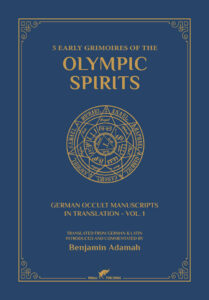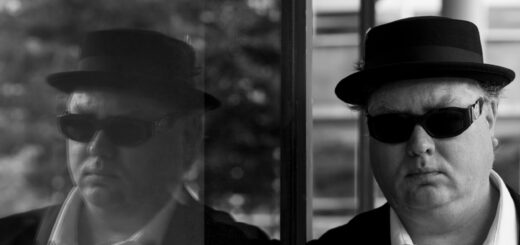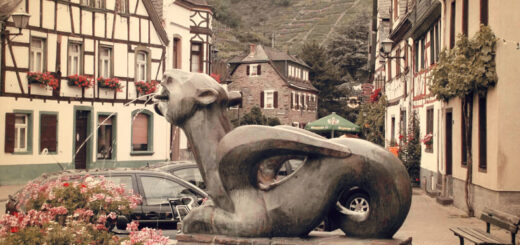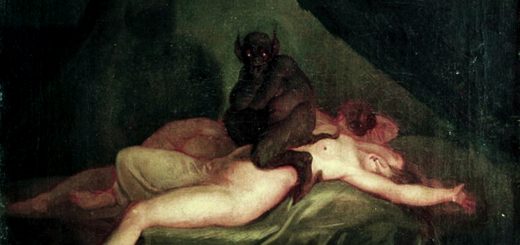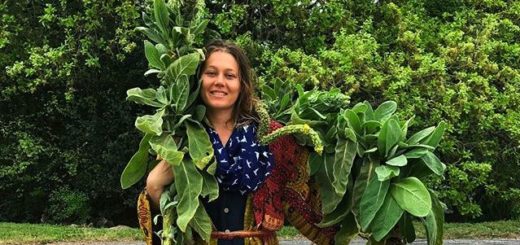Jack-o’-lantern, its origin and connection with Will-o’-the-wisp
In the United States, the celebration of Halloween made its appearance mainly in the second half of the 19th century, when large groups of Irish and Scottish immigrants entered the country. During this time, the famous Jack-o’-lantern, a hollowed-out pumpkin resembling a face, appeared in the U.S. Worldwide, this has become perhaps the best-known symbol of Halloween. But what exactly is the story behind this popular phenomena at the end of a very old tradition? Is it just an American thing? And what has Will-o’-the-wisp has to do with it?
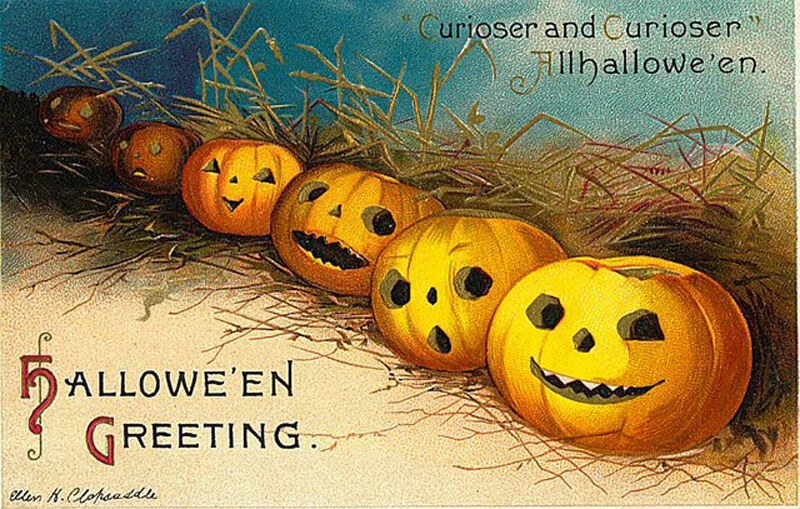
Vintage halloween postcard showing a row of jack-o-lanterns
For a large part of the 20th century, Halloween in the U.S. was primarily a children’s party. During this children’s party, children (often accompanied by an elder) go trick-or-treating at night. The intention is to scare the person who answers the door. Often the resident has candy in the house, from which the children can choose.
The houses that participate are recognizable by visible Halloween decorations. Starting in the 1980s, it also became increasingly a celebration for adults. The dressing up and the creepy aspect became more and more important. Hollywood exploited Halloween as a base for horror movies. This pushed the commercialization of the tradition and the last two decades it even spread to our country, the Netherlands. The commerce driven popularisation of Halloween, however, went parallel with the loss of knowledge of its ancient Celtic roots.

Vintage Halloween postcard with Jack-o’-lantern
Samhain
The name “Halloween” is derived from Hallow-e’en, or All Hallows Eve, the night before All Saints Day, November 1. In the Celtic calendar, the year began on November 1, so October 31 was New Year’s Eve. The harvest was then in, the seed for the next year was ready and so there was some time for a day off, the Celtic New Year or Samhain (which has also become the Irish word for the month of November).
Samhain was also very special for another reason. On the island of Britain, Halloween was celebrated primarily by the Celts, who believed that on that day, the spirits of all the dead from the previous year returned to try to take possession of a living body for the coming year. The spirits that would rise from dead people were attracted by placing food in front of the doors for them. However, to ward off evil spirits, the Celts wore masks. When the Romans invaded Britain, they mixed the Celtic tradition with their own, which at the end of October, of course, involved celebrating the harvest and also honoring the dead.
In astrology, the degrees of Scorpio, which transits the sun during the last days of October and the first of November, are associated with the thinning of the boundary between our earthly world and the world of the spirits and dead.
The carving of Jack-o’-lanterns at Hallowe’en time
Carving of vegetables has been a common practice in many parts of the world. It is believed that the custom of making Jack-o’-lanterns at Hallowe’en time began in Ireland. In the 19th century, “turnips or mangel wurzels, hollowed out to act as lanterns and often carved with grotesque faces,” were used on Halloween in parts of Ireland and the Scottish Highlands. In these Gaelic-speaking regions, Halloween fused with the festival of Samhain, was seen as a time when supernatural beings (the Aos Sí), and the souls of the dead, walked the earth. Jack-o’-lanterns were also made at Halloween time in Somerset, England during the 19th century. The last Thursday of October is called Punkie Night in Somerset, a traditional West Country holiday on which children will march around with a jack o’lantern.
By those who made them, the lanterns were said to represent either spirits or supernatural beings, or were used to ward off evil spirits. For example, sometimes they were used by Halloween participants to frighten people, and sometimes they were set on windowsills to keep harmful spirits out of one’s home. It has also been suggested that the Jack-o’-lanterns originally represented Christian souls in purgatory, as Halloween is the eve of All Saints’ Day (1 November)/All Souls’ Day (2 November).
On Halloween in 1835, the Dublin Penny Journal published a long story on the legend of “Jack-o’-the-Lantern”. In 1837, the Limerick Chronicle refers to a local pub holding a carved gourd competition and presenting a prize to “the best crown of Jack McLantern”. The term “McLantern” also appears in an 1841 publication of the same paper.
There is also evidence that turnips were used to carve what was called a “Hoberdy’s Lantern” in Worcestershire, England, at the end of the 18th century. The folklorist Jabez Allies outlines other derivations of the name, “Hobany’s”, which is most likely derived from “Hob and his”, with other variations including “Hob-o’-Lantern”, “Hobbedy’s Lantern” and “Hobbady-lantern”.
https://vamzzz.com/product/the-book-of-halloween/

Vintage Haloween card depicting Jack-o’-lantern with the Devil
Jack-o’-lantern – the legend of a blacksmith cheating the Devil
The tradition for making jack-o’-lanterns originated in Ireland. There are many stories about the origin of the lantern. One of the best known is the 18th century Irish folk tale of the blacksmith Jack or Stingy Jack. One night Jack met the devil who wanted to take him to hell. Jack managed to lure the devil into an apple tree, and then scratched a cross into the trunk of the tree so that the devil could no longer leave the tree. Only after the devil promised Jack that he would never have to go to hell did Jack remove the cross sign and release the devil.
When Jack died years later, his bad walk of life did not allow him to go to heaven, but the devil also did not let him into hell because of the promise made. Since then, according to the story, Jack’s soul has been wandering around the earth. The devil did throw a glowing coal after Jack when he sent him away from the gate of hell. Jack put the coal in a tuber he was eating and thus got a lantern to light his way. Hence he became known as “Jack of the Lantern”, or Jack o’lantern. In the Halloween tradition originally tubers were used to make the lanterns, but Irish immigrants to America soon discovered that the pumpkin was a lot more suitable for.
The Jack-o’-lantern legend is similar to the story of Will-o’-the-wisp
The story of the Jack-o’-lantern comes in many forms and is similar to the story of Will-o’-the-wisp retold in different forms across Western Europe, including, Italy, Norway, Spain and Sweden. In Switzerland, children will leave bowls of milk or cream out for mythical house spirits called Jack o’ the bowl.
An alterternative Jack-o’-lantern story says that one day Jack was getting chased by some villagers from whom he had stolen. He then met Satan, who claimed it was time for him to die. However, the thief stalled his death by tempting Satan with a chance to bedevil the church-going villagers chasing him. Jack told Satan to turn into a coin with which he would pay for the stolen goods (Satan could take on any shape he wanted); later, when the coin (Satan) disappeared, the Christian villagers would fight over who had stolen it. The Devil agreed to this plan. He turned himself into a silver coin and jumped into Jack’s wallet, only to find himself next to a cross Jack had also picked up in the village. Jack closed the wallet tight, and the cross stripped the Devil of his powers; and so he was trapped.
In both the folktale with the apple tree and the one with the purse, Jack lets Satan go only after he agrees to never take his soul. Many years later, the thief died, as all living things do. Cornish folklorist Dr. Thomas Quiller Couch (d. 1884) recorded the use of the term in a rhyme used in Polperro, Cornwall, in conjunction with Joan the Wad, the Cornish version of Will-o’-the-wisp. The people of Polperro regarded them both as pixies. The rhyme goes:
Jack o’ the lantern! Joan the wad,
Who tickled the maid and made her mad
Light me home, the weather’s bad.
Jack-o-lanterns were also a way of protecting one’s home against the undead. People used them specifically to ward off vampires. It was said that the Jack-o-lantern’s light was a way of identifying vampires who, once their identity was known, would give up their hunt for you.

The ignis fatuus, or Will-o’-the-wisp. Coloured wood engraving by C. Whymper (1853-1941)
Ignis fatuus or Will-o’-the-wisp
Etymological study shows that – apart from the later legends of Jack – the term Jack-o’-lantern was originally used to describe the visual phenomenon ignis fatuus (lit., “foolish fire”) known as a will-o’-the-wisp in English folklore. Used especially in East England, its earliest known use dates to the 1660s. The term “will-o’-the-wisp” uses “wisp” (a bundle of sticks or paper sometimes used as a torch) and the proper name “Will”: thus, “Will-of-the-torch.” The term Jack o’lantern is of the same construction: “Jack of [the] lantern.”
In folklore, a Will-o’-the-wisp, Will-o’-wisp or ignis fatuus (Latin for ‘giddy flame’, plural ignes fatui), is an atmospheric ghost light seen by travelers at night, especially over bogs, swamps or marshes. The phenomenon is known in English folk belief, English folklore and much of European folklore by a variety of names, apart from Jack-o’-lantern, other names are: friar’s lantern, hinkypunk and hobby lantern and is said to mislead travelers by resembling a flickering lamp or lantern. In literature, Will-o’-the-wisp metaphorically refers to a hope or goal that leads one on but is impossible to reach or something one finds sinister and weird.
Wills-o’-the-wisp appear in folk tales and traditional legends of numerous countries and cultures; notable Wills-o’-the-wisp include St. Louis Light in Saskatchewan, The Spooklight in Southwestern Missouri, Marfa lights of Texas, the Naga fireballs on the Mekong in Thailand, the Paulding Light in Upper Peninsula of Michigan and the Hessdalen light in Norway.
In urban legends and folklore, Wills-o’-the-wisp are typically attributed to ghosts, fairies or elemental spirits. Modern science explains them as natural phenomena such as bioluminescence or chemiluminescence, caused by the oxidation of phosphine (PH3), diphosphane (P2H4) and methane (CH4) produced by organic decay.
The Latin ignis fatuus is documented no earlier than the 16th century in Germany, where it was coined by a German humanist, and appears to be a free translation of the long-existing German name Irrlicht (“wandering light”) conceived of in German folklore as a mischievous spirit of nature; the Latin translation was made to lend the German name intellectual credibility. Beside Irrlicht, the Will-o’-the-wisp has also been called in German Irrwisch (where Wisch translates to “wisp”), as found in e.g. Martin Luther’s writings of the same 16th century.

“Will-o-the-wisp and snake” by Hermann Hendrich, 1823
Hobby lanterns
Folk belief attributes the phenomenon to fairies or elemental spirits, explicitly in the term “hobby lanterns” found in the 19th century Denham Tracts. In her book A Dictionary of Fairies, K. M. Briggs provides an extensive list of other names for the same phenomenon, though the place where they are observed (graveyard, bogs, etc.) influences the naming considerably. When observed in graveyards, they are known as “ghost candles”, also a term from the Denham Tracts. The names Will-o’-the-wisp and Jack-o’-lantern are used in etiological folk-tales, recorded in many variant forms in Ireland, Scotland, England, Wales, Appalachia, and Newfoundland.
https://vamzzz.com/product/the-banshee/
Will-o’-the-wisp in the European mainland tradition
In European folklore, Will-o’-the-wisp are believed to be spirits of the dead, fairies, or a variety of other supernatural beings which attempt to lead travelers to their demise. Sometimes the lights are believed to be the spirits of unbaptized or stillborn children, flitting between heaven and hell.
In Sweden, the Will-o’-the-wisp represents the soul of an unbaptized person “trying to lead travellers to water in the hope of being baptized”. Danes, Finns, Swedes, Estonians, Latvians, Lithuanians, and Irish people and amongst some other groups believed that a Will-o’-the-wisp also marked the location of a treasure deep in ground or water, which could be taken only when the fire was there.
Sometimes magical tricks, and even dead man’s hand, were required as well, to uncover the treasure. In Finland and several other northern countries, it was believed that early autumn was the best time to search for Wills-o’-the-wisp and treasures below them. It was believed that when someone hid treasure, in the ground, he made the treasure available only at the Saint John’s Day, and set Will-o’-the-wisp to mark the exact place and time so that he could come to take the treasure back. For then he could be fulfilled with treasures.
The Aarnivalkea, in Finnish mythology, are spots where an eternal flame associated with wills o’ the wisp burns. They are claimed to mark the places where faerie gold is buried. They are protected by a glamour that would prevent anyone finding them by pure chance. However, if one finds a fern seed from a mythical flowering fern, the magical properties of that seed will lead the fortunate person to these treasures, in addition to providing one with a glamour of invisibility. Since in reality the fern produces no flower and reproduces via spores under the leaves, the myth specifies that it blooms only extremely rarely.

Vintage Halloween postcard showing a black cat surrounded by Jack-o’-lantern
You may also like to read:
Spirit Beings of European Folklore
Walpurgis Night
The Banshee
Black Cat Superstitions
An Authenticated Vampire Story
Mysteries of the Ancient Oaks


